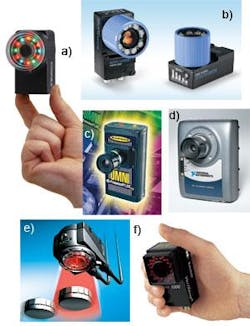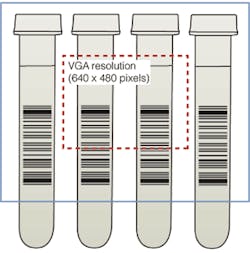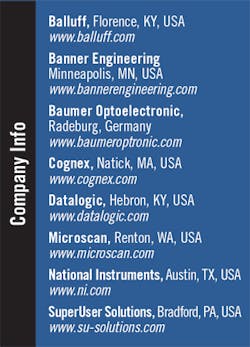Sensors tackle machine-vision applications
Vision sensors are closing the gap between traditional photoelectric sensors and more complex image-processing systems.
At Pack Expo in Las Vegas, NV, USA (October 2007) this year, one emerging trend that was evident was incorporating more sophisticated machine-vision systems into packaging and production systems. But those expecting to see sophisticated machine-vision systems integrating expensive telecentric lenses, large-format cameras, high-speed Camera Link frame grabbers, and image-processing software would surely have been disappointed.
While many systems featured relatively low-cost devices to read one- and two-dimensional (1-D and 2-D) barcodes, very few used more costly components with which to perform machine-vision tasks. The reason, it seems, is multifold. Although many packaging-system designers would like to incorporate machine vision into their systems, the expense of developing and deploying such systems is prohibitive.
What developers are looking for is an inexpensive way to rapidly deploy single products that perform simple functions such as presence detection, color analysis, and barcode reading. Familiar with using low-cost programmable logic controllers (PLCs), system integrators are now exploring the uses of smart vision sensors to perform these functions without the need to understand how to develop or deploy machine-vision algorithms.
Of course, this trend is not new. One of the first companies to recognize the demand for a low-cost way to solve relatively simple machine-vision tasks was DVT, now part of Cognex. Rather than develop simple barcode readers, DVT’s concept was to develop relatively inexpensive, compact, rugged vision sensors that incorporated the functions of a smart camera and PLC. These include an integrated imager, memory, processor, Ethernet, and digital I/O capability, along with the company’s Intellect software that uses an intuitive user interface and a library of easy-to-configure vision tools.
For the packaging and production industry, ease of mounting, industrial connectors, and integrated lighting of smart sensors provided a way to migrate from the limitations of photoelectric sensors to provide additional functionality with a moderate cost increase. It is a concept that has been further extended by Cognex in its latest Checker 200 series (see Vision Systems Design, June 2007, p. 22).
New products emerge
Realizing the success of these products, other companies are now developing similar smart vision sensors with different levels of sophistication (Click here to view a PDF of the table on page 42). Interestingly, these companies are emerging from existing manufacturers of low-cost barcode readers, companies known for industrial control products, and existing machine-vision vendors. While many offer smart vision sensors firmly targeted toward 1- and 2-D barcode reading, more sophisticated machine-vision functions are slowly being added to these products.
One thing is apparent when comparing these products. Many of the technical hardware specifications are very similar. Nearly all of the smart sensors on the market today offer integrated sensors, processors, memory, digital I/O, networking capability, and LED lighting. Even more noticeable, the design of such products is also strikingly similar to products originally developed by DVT (see Fig. 1).
The choice of which smart sensor to use is firmly application-dependent. The sensor size, frame rate, type of built-in lenses, and lighting must be carefully considered. Perhaps more important, however, developers should properly evaluate the software that is supplied with the device. While many smart sensor vendors offer families of devices suited to different types of applications, the software that is supplied with each family of sensors remains consistent.
More than barcodes
By embedding specific types of software in their smart vision sensors, some manufacturers can offer application-specific products such as barcode/OCR/OCV readers. Others are choosing to offer software development kits to either allow companies to tailor the products for high-volume end users or for OEMs to tailor these products for specific applications. At a more sophisticated level, graphical user interfaces (GUIs) are available that allow a developer to create host-based machine-vision applications and download them to the smart sensor so that it can run autonomously on a packaging or production line.
For example, at Pack Expo Datalogic introduced two versions of its Matrix 400 smart sensor targeted directly toward direct-part-mark reading of 1-D, 2-D stacked, and postal symbologies. Two versions of the sensor are available that feature either 1.3-Mpixel SXGA or 2-Mpixel UXGA sensors, internal LEDs, and adjustable C-mount lenses. A multifunction pushbutton sets all relevant functions such as aiming, focusing, automatic imager calibration, and code setting.
Other manufacturers are realizing that the embedded capabilities of smart sensors allow them to be used for a wider range of applications. Emerging from the highly competitive barcode-inspection market, for example, Microscan recently demonstrated how its MS-4 EZ Match imager could be used to perform more than barcode-recognition functions.
Over the last four years, most array imagers have read at VGA resolution (640 × 480) with 307,200 pixels. This has forced instrument designers to choose between resolution and field of view. Megapixel imagers with SXGA resolution (1280 × 1024), however, deliver a larger field of view without sacrificing resolution (see Fig. 2). So the MS-4 EZ Match can read barcoded test tubes or combinations of linear and 2-D symbols while capturing the height of the test tube and its cap for inspection. In operation, the imager can read and decode both long linear and high-density 2-D symbols such as Data Matrix, the status of the test tube’s position, the presence or absence of a cap, the cap’s diameter, and the tube height.
Graphical user interfaces
While vendors such as Microscan are moving toward offering ever smarter vision sensors, other manufacturers, notably Balluff, Banner Engineering, Baumer Optoelectronic, Cognex, and National Instruments (NI), are offering more fully featured smart vision sensors designed to perform a range of functions. As well as offering smart vision sensors, these companies offer PC-based software packages that use intuitive GUIs with which to configure the sensor (see Fig. 3). Once configured, the machine-vision program is downloaded to the sensor so that it can operate autonomously on a production line.
A good example is Banner Engineering’s PresencePLUS series. Designed for those with a minimal knowledge of machine vision, inspections are set up using a PC. The sensor captures images, and the PresencePLUS software analyzes captured images using one or more vision tools to pass or fail the product. After the inspection files have been stored in the sensor’s memory, the software can be run autonomously. Inspection setup involves focusing the lens and selecting the appropriate analysis tools. Because the sensor accommodates both translational and rotational variation, parts moving down a production line or web need not be oriented in exactly the same way.
Also at Pack Expo, SuperUser Solutions demonstrated an integrated labeling and verification system that speeds packaging production using the PresencePLUS sensor for the less-complex task of barcode inspection. After configuring the sensor to operate over an Ethernet, discrete I/O and inspection pass/fail information regarding each package barcode are transferred. After each label is read, the barcode information is displayed on an operator interface and is tied to a reject mechanism or an alarm to alert the operator of misread codes (see p. 13).
Like Banner Engineering, NI realized the power of graphical-user-interface-based software when it debuted two such vision sensors developed for packaging inspection, assembly verification, 1- and 2-D code reading, and motion guidance at NIWeek (August 2007; Austin, TX, USA). With the combination of a PowerPC processor, CCD imager, in-built LED illumination, digital I/O, and a Gigabit Ethernet interface, both the 1722 and 1742 smart cameras can run NI Vision Builder for Automated Inspection or NI LabVIEW Real-Time module and suite of vision algorithms (see Vision Systems Design, October 2007, p. 74).
NI also demonstrated how they could be used to sort and check colored bottles. In this application, the smart sensors were integrated with PLCs, smart HMI interfaces and the company’s CompactRIO programmable automation controller in a system that sorted different colored bottles and aligned and inspected these labels for quality (see Vision Systems Design, October 2007, p. 21).
In developing its Sharpshooter smart sensor, engineers at Balluff realized the need to offer a simple, easy-to-use GUI. Balluff offers its own GUI software, known as ConVis, that uses a step-by-step configuration process to guide developers through sensor setup. With a multiple image-viewing buffer to identify a reference image for setup, the PC-based ConVis software also operates as an emulator to allow projects to be set up and tested off-line and then downloaded to the sensor over Ethernet.
Similarly, Baumer Optronic’s VeriSens vision sensors use an application suite of configurable software running on a PC or laptop. Up to 32 features can be used for a single inspection of a typical product or its surrounding. Each product’s configuration and inspection parameters are stored within one of the 255 supported jobs, which are selected at runtime via digital input.
Recently, the company demonstrated how the VeriSens Series 1000 ould detect the correct alignment of blister packs and cardboard packaging (see Fig. 4). First, three horizontal and vertical positions are detected by the sensor. The reference edge shown on the left is estimated with two horizontal and vertical search arrows. Then the position and orientation of this edge is compared with its expected position. Finally, the vision sensor checks the alignment of the blister pack with respect to the reference edge. Process tolerances are determined by the length of the arrows. Results are sent to the vision sensor’s output, which is connected to a PLC.
null





